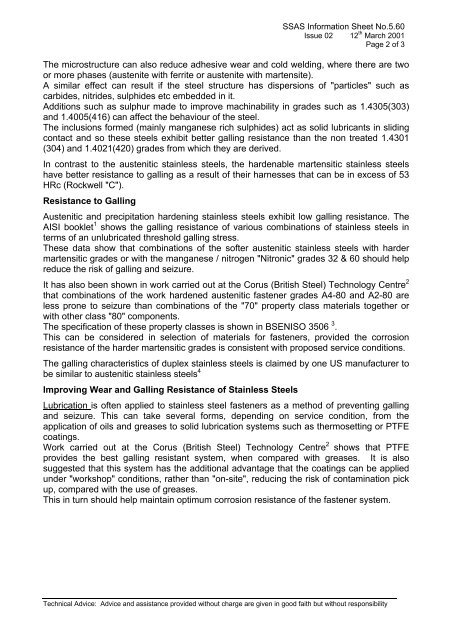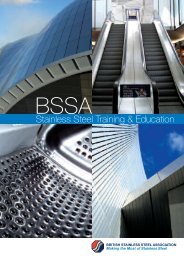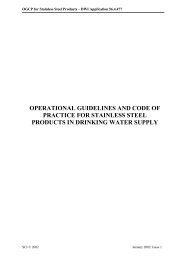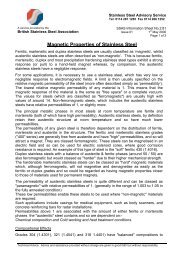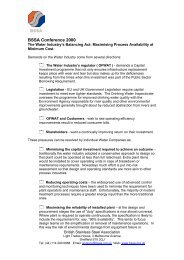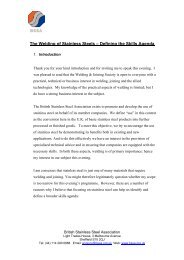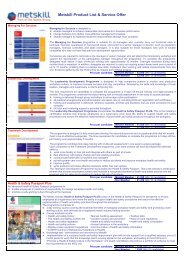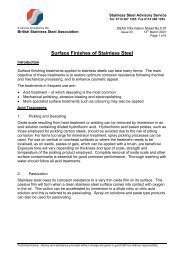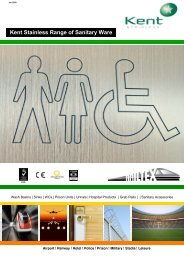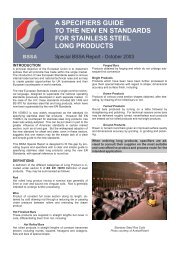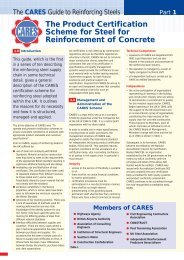Information Sheet No - British Stainless Steel Association
Information Sheet No - British Stainless Steel Association
Information Sheet No - British Stainless Steel Association
Create successful ePaper yourself
Turn your PDF publications into a flip-book with our unique Google optimized e-Paper software.
SSAS <strong>Information</strong> <strong>Sheet</strong> <strong>No</strong>.5.60<br />
Issue 02 12 th March 2001<br />
Page 2 of 3<br />
The microstructure can also reduce adhesive wear and cold welding, where there are two<br />
or more phases (austenite with ferrite or austenite with martensite).<br />
A similar effect can result if the steel structure has dispersions of "particles" such as<br />
carbides, nitrides, sulphides etc embedded in it.<br />
Additions such as sulphur made to improve machinability in grades such as 1.4305(303)<br />
and 1.4005(416) can affect the behaviour of the steel.<br />
The inclusions formed (mainly manganese rich sulphides) act as solid lubricants in sliding<br />
contact and so these steels exhibit better galling resistance than the non treated 1.4301<br />
(304) and 1.4021(420) grades from which they are derived.<br />
In contrast to the austenitic stainless steels, the hardenable martensitic stainless steels<br />
have better resistance to galling as a result of their harnesses that can be in excess of 53<br />
HRc (Rockwell "C").<br />
Resistance to Galling<br />
Austenitic and precipitation hardening stainless steels exhibit low galling resistance. The<br />
AISI booklet 1 shows the galling resistance of various combinations of stainless steels in<br />
terms of an unlubricated threshold galling stress.<br />
These data show that combinations of the softer austenitic stainless steels with harder<br />
martensitic grades or with the manganese / nitrogen "Nitronic" grades 32 & 60 should help<br />
reduce the risk of galling and seizure.<br />
It has also been shown in work carried out at the Corus (<strong>British</strong> <strong>Steel</strong>) Technology Centre 2<br />
that combinations of the work hardened austenitic fastener grades A4-80 and A2-80 are<br />
less prone to seizure than combinations of the "70" property class materials together or<br />
with other class "80" components.<br />
The specification of these property classes is shown in BSENISO 3506 3 .<br />
This can be considered in selection of materials for fasteners, provided the corrosion<br />
resistance of the harder martensitic grades is consistent with proposed service conditions.<br />
The galling characteristics of duplex stainless steels is claimed by one US manufacturer to<br />
be similar to austenitic stainless steels 4<br />
Improving Wear and Galling Resistance of <strong>Stainless</strong> <strong>Steel</strong>s<br />
Lubrication is often applied to stainless steel fasteners as a method of preventing galling<br />
and seizure. This can take several forms, depending on service condition, from the<br />
application of oils and greases to solid lubrication systems such as thermosetting or PTFE<br />
coatings.<br />
Work carried out at the Corus (<strong>British</strong> <strong>Steel</strong>) Technology Centre 2 shows that PTFE<br />
provides the best galling resistant system, when compared with greases. It is also<br />
suggested that this system has the additional advantage that the coatings can be applied<br />
under "workshop" conditions, rather than "on-site", reducing the risk of contamination pick<br />
up, compared with the use of greases.<br />
This in turn should help maintain optimum corrosion resistance of the fastener system.<br />
Technical Advice: Advice and assistance provided without charge are given in good faith but without responsibility


